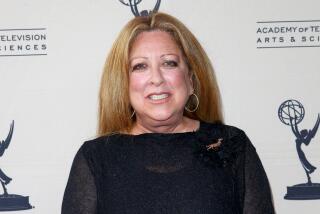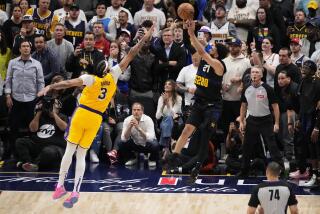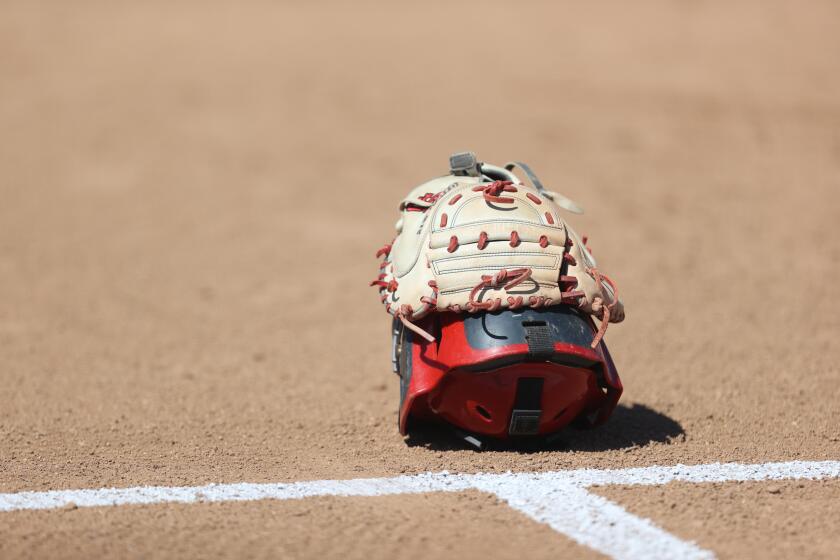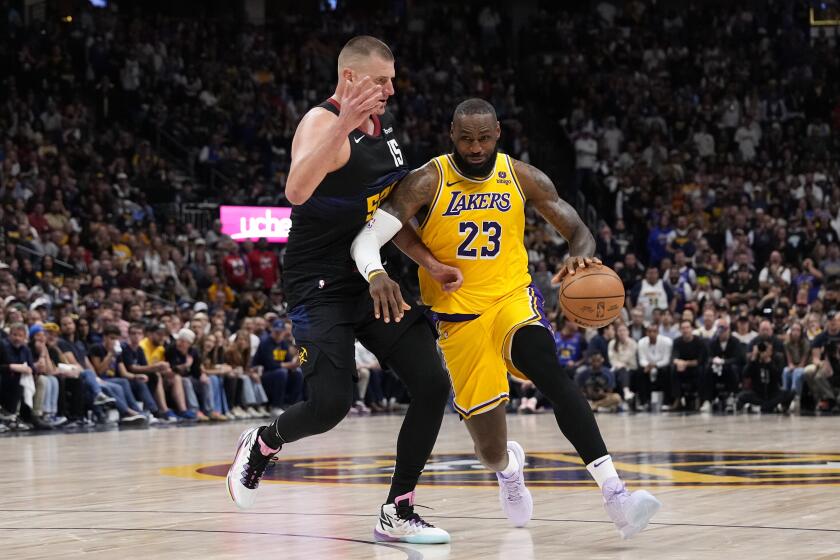Billy Graham’s star was born at his 1949 revival in Los Angeles
During a career spanning more than half a century, religious crusader the Rev. Billy Graham urged presidents, gangsters and African lepers to “take Christ into your heart and be saved.”
But it was his first crusade, in Los Angeles in 1949, that catapulted him to religious stardom.
He called it the Greater Los Angeles Billy Graham Crusade at the “Canvas Cathedral With the Steeple of Light.” Graham, then 30, drew 350,000 people over eight weeks to a huge tent at Washington Boulevard and Hill Street. About 3,000 nonbelievers committed their lives to Christ, according to Times stories then.
On Sept. 25, 1949, the young Southern Baptist preacher from North Carolina launched his L.A. crusade, sponsored by hundreds of Christian leaders in Southern California. The faithful filled the seats each night, with thousands more standing outside or listening in parked cars, as Graham quoted Scripture and discussed his tours of Europe after World War II.
“All across Europe, people know that time is running out,” he said. “Now that Russia has the atomic bomb, the world is in an armament race driving us to destruction.”
The press called it the greatest revival since the fire and brimstone evangelism of flamboyant early 20th century preacher Billy Sunday.
Among the many who turned out was former teenage delinquent and Olympic track star Lou Zamperini, now 90. Zamperini roomed with Jesse Owens at the 1936 Berlin Olympics, stole a Nazi flag from the German chancellery during the Games and shook the hand of Adolf Hitler.
During World War II, he survived 47 days on a raft in the Pacific, only to be rescued by the Japanese, who put him through horrors as a prisoner of war. But he says Graham saved his life.
“I was a mess,” Zamperini said in a recent interview. “I fell apart after the war. I was a drunk. I suffered terrible nightmares and was having marital problems.
“But my wife was a determined woman who dragged me down to see Graham. I walked out mad the first time. I didn’t want to hear that I had sinned. Just to shut her up, I went back.”
Then something clicked.
“I had a flashback about sitting there on a life raft. I came home alive and never thanked God. I felt terribly ashamed. When I got off my knees, I knew I was through getting drunk,” he said. “Billy Graham helped save me.”
Word that Hollywood celebrities were “stepping forward to receive Christ” reached publishing magnate William Randolph Hearst, who sent a two-word telegram to every editor in his newspaper chain: “Puff Graham.”
Graham told The Times in 2004 that he learned about it from two of Hearst’s sons. They believed their father came to the 1949 revival in his wheelchair and in disguise, accompanied by his longtime mistress, actress Marion Davies. Hearst’s intervention prompted the revival to run eight weeks -- five weeks longer than planned. Hearst died less than two years later.
“I never met him and I never corresponded with him,” Graham said. “I should have written him and thanked him.”
During the 1949 revival, underworld wiretapper James Arthur Vaus Jr. was born again and joined Graham’s crusade. Vaus introduced Graham to his former boss, L.A. mobster Mickey Cohen.
Graham said he was invited to Cohen’s Brentwood home. “We had a very pleasant social visit,” the evangelist told the press. “He served us soft drinks.”
Thousands of people, he said, “are praying all the time for Mickey Cohen to get religion. It is my feeling that undue publicity that might be given to this situation could be a discouraging factor.”
Reporters hurried to Cohen, who denied meeting Graham.
“I don’t know what this is all about,” Cohen told the press. “ I don’t know him, I’ve never seen him and I’ve never talked to him. . . . I’m a Jew.”
Two years later, The Times reported that Graham and Cohen had dined at a Sunset Strip restaurant. Within a week, reporters got a tip that Graham was going to meet Cohen -- and one of the oddest incidents in Graham’s career ensued.
Among those who had joined Graham’s fold in 1949 was cowboy singer-songwriter Stuart Hamblen. In 1951, Hamblen was chauffeuring the evangelist when a passel of reporters and photographers gave chase, hoping to see Graham meet Cohen.
“Hamblen, who once owned a fast-stakes horse named El Lobo, immediately poured on the oats,” The Times reported. After a high-speed pursuit along Wilshire Boulevard, Hamblen stopped, got out of his car and angrily told reporters: “You’re trying to ruin a year’s work. We’re going to a meeting with some important Hollywood stars. They don’t want publicity.”
Some of those stars included Jane Russell, Dennis Morgan, Virginia Mayo, Porter Hall, Connie Haines, Michael O’Shea, Roy Rogers and Dale Evans.
Russell, a sassy, brassy, buxom bombshell, was nothing like her public image, actress June Lockhart said in a recent interview: “She regularly held Bible classes in her home.”
Russell, now 86, starred in “Gentlemen Prefer Blondes” and hung out with Howard Hughes. But she gave her heart to the Lord at age 5, she said in a recent interview.
“I had four brothers who built my mother a small amphitheater, surrounded by trees, at our two-acre Van Nuys home, where we held Friday night prayer meetings for relatives and studio folk,” Russell said.
“I remember wheeling a former soldier, wounded in the war, down that sawdust aisle [in 1949] to meet Billy and receive the Lord. I can’t remember his name, but I remember how happy it made me, and him too.”
Russell still sings and dances on stage in Santa Maria, where she lives.
Lockhart said she herself was spellbound at Graham’s 1957 Madison Square Garden crusade. “Just to see the power he had was such a volatile experience,” she said.
Another disciple was Edward O. Garver, pastor of a Yucca Valley church. He took a leave to journey to Los Angeles and pass out hymnals during Graham’s daytime revival meetings. At night, he worked as a watchman at the big tent, where he prayed with those who had arrived too late to see Graham.
“I heard the shuffle of their feet and sobs in the darkness,” he told The Times in 1949.
Evelyn Penner Harrison, now 76, came to hear Graham too.
“I was 18 then, and remember going alone, taking the bus and a streetcar to get there,” she said in a recent interview. “Ever since that 1949 revival, I’ve loved going to Christian concerts and prayer meetings. Anything connected to the Grahams, and I am there.”
Today, she is a retired teacher living in San Dimas.
On Nov. 20, 1949, as the 57-day revival closed, Graham preached his 65th sermon and final message: “The revival that started here won’t end with the folding of this tent,” he said. “This is not it yet, but revival will come.”
He continued: “I have in my pocket a telegram from the Philadelphia Presbytery that 125 pastors there are praying that this campaign will launch a nationwide revival.”
And so it did. Graham held more than 400 crusades worldwide. He came back to Los Angeles at least eight times, most recently in 2004.
Graham, now 88 and in ill health, was released last week from the hospital. His wife of 64 years, Ruth, died in June from complications of pneumonia. The old canvas tent where he held his first blockbuster is on display at his new 40,000-square-foot museum in Charlotte, N.C.
But he remains a modest man -- unlike some televangelists who might come to mind. The museum was his supporters’ idea. Graham reluctantly gave it his blessing only because he was persuaded that the project would serve as a perpetual crusade, a tribute not to him but to Jesus Christ.
After he toured it in May, however, he said gruffly: “Too much Billy Graham.”
More to Read
Get our high school sports newsletter
Prep Rally is devoted to the SoCal high school sports experience, bringing you scores, stories and a behind-the-scenes look at what makes prep sports so popular.
You may occasionally receive promotional content from the Los Angeles Times.






